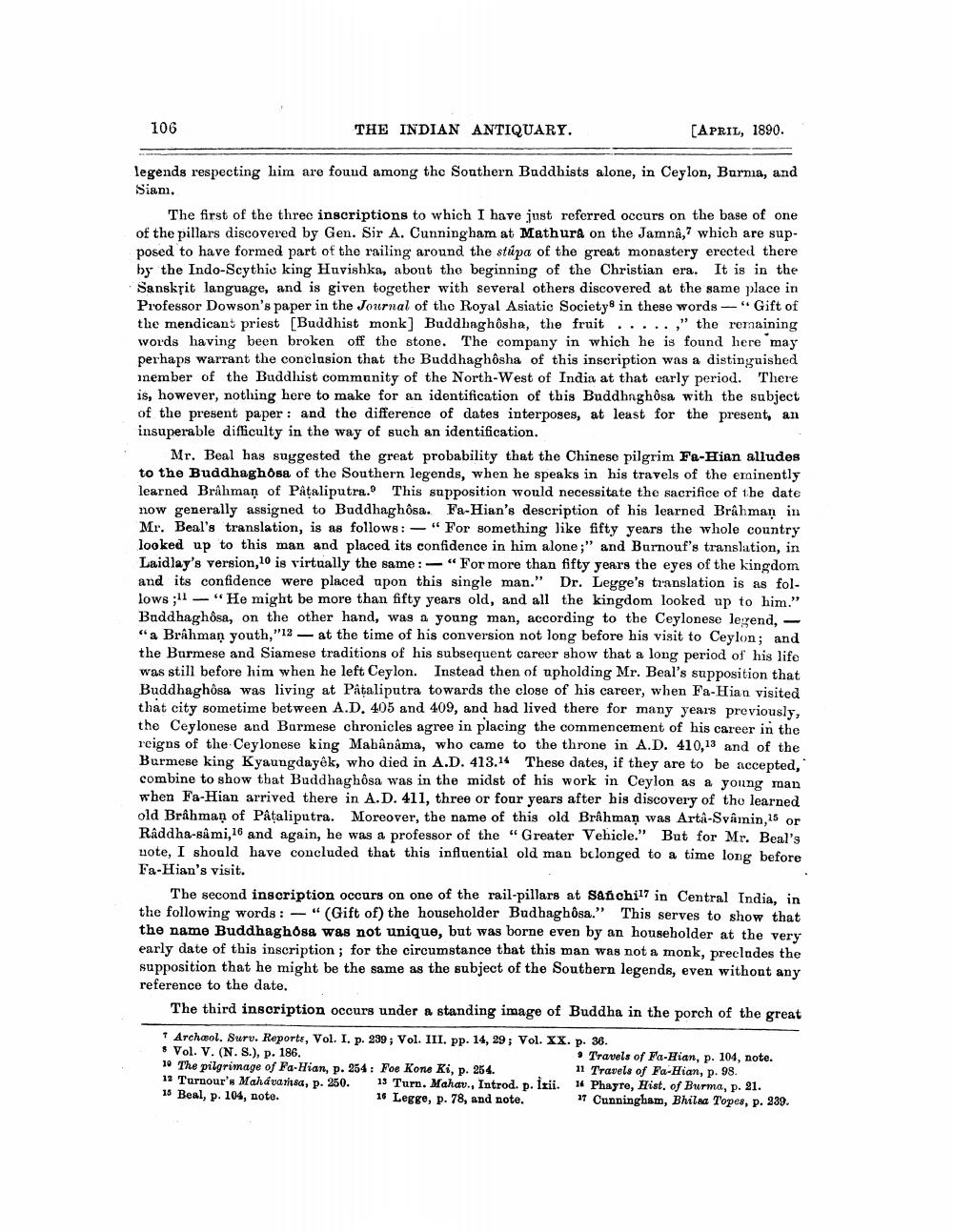________________
106
THE INDIAN ANTIQUARY.
(APRIL, 1890.
legends respecting him are found among the Southern Buddhists alone, in Ceylon, Barna, and Siam.
The first of the three inscriptions to which I have just referred occurs on the base of one of the pillars discovered by Gen. Sir A. Cunningham at Mathura on the Jamna, which are supposed to have formed part of the railing around the stúpa of the great monastery erected there by the Indo-Scythic king Huvishka, about the beginning of the Christian era. It is in the Sanskrit language, and is given together with several others discovered at the same place in Professor Dowson's paper in the Journal of the Royal Asiatic Society in these words - "Gift of the mendicant priest [Buddhist monk] Buddhaghôsha, the fruit .....," the remaining words having been broken off the stone. The company in which he is found here may perhaps warrant the conclusion that the Buddhaghôsha of this inscription was a distinguished inember of the Buddhist community of the North-West of India at that early period. There is, however, nothing here to make for an identification of this Buddhnghôsa with the subject of the present paper : and the difference of dates interposes, at least for the present, an insuperable difficulty in the way of such an identification.
Mr. Beal has suggested the great probability that the Chinese pilgrim Fa-Hian alludes to the Buddhaghosa of the Southern legends, when he speaks in his travels of the eminently learned Brahman of Pataliputra. This supposition would necessitate the sacrifice of the date now generally assigned to Buddhaghôsa. Fa-Hian's description of his learned Brahman in Mr. Beal's translation, is as follows: "For something like fifty years the whole country looked up to this man and placed its confidence in him alone;" and Burnouf's translation, in Laidlay's version, 10 is virtually the same:-“For more than fifty years the eyes of the kingdom and its confidence were placed upon this single man." Dr. Legge's translation is as follows ;11 - "He might be more than fifty years old, and all the kingdom looked up to him." Buddhaghsa, on the other hand, was a young man, according to the Ceylonese legend, - “a Brahman youth,"12 - at the time of his conversion not long before his visit to Ceylon; and the Burmese and Siamese traditions of his subsequent career show that a long period of his life was still before him when he left Ceylon. Instead then of upholding Mr. Beal's supposition that Buddhaghôsa was living at Pâtaliputra towards the close of his career, when Fa-Hian visited that city sometime between A.D. 405 and 409, and had lived there for many years previously, the Ceylonese and Burmese chronicles agree in placing the commencement of his career in the reigns of the Ceylonese king Mabânama, who came to the throne in A.D. 410,13 and of the Burmese king Kyaungdayék, who died in A.D. 413.14 These dates, if they are to be accepted, combine to show that Buddhaghôsa was in the midst of his work in Ceylon as a young man when Fa-Hian arrived there in A.D. 411, three or four years after his discovery of the learned old Brahman of Pataliputra. Moreover, the name of this old Brahman was Arta-Svâmin,15 or Raddha-så mi, 16 and again, he was a professor of the "Greater Vehicle." But for Mr. Beal's uote, I should have concluded that this influential old man belonged to a time long before Fa-Hian's visit.
The second inscription occurs on one of the rail-pillars at Sanchil7 in Central India, in the following words : - " (Gift of) the householder Budhaghosa." This serves to show that the name Buddhaghosa was not unique, but was borne even by an householder at the very early date of this inscription ; for the circumstance that this man was not a monk, precludes the supposition that he might be the same as the subject of the Southern legends, even without any reference to the date.
The third inscription occurs under a standing image of Buddha in the porch of the great
+ Archæol. Surv. Reports, Vol. I. p. 239; Vol. III. pp. 14, 29; Vol. XX. p. 38. • Vol. V. (N. S.), p. 186.
• Travels of Fa-Hian, p. 104, note. 10 The pilgrimage of Fa-Hian, p. 254: Foe Kone Ki, p. 254.
11 Travels of Fa-Hian, p. 98. 12 Turnour's Mahávarsa, p. 250. 13 Turn. Mahav., Introd. p. Ixii. 4 Phayre, Hist. of Burma, p. 21. 15 Beal, p. 104, note.
16 Legge, p. 78, and note. 17 Cunningham, Bhilaa Topes, p. 239.




